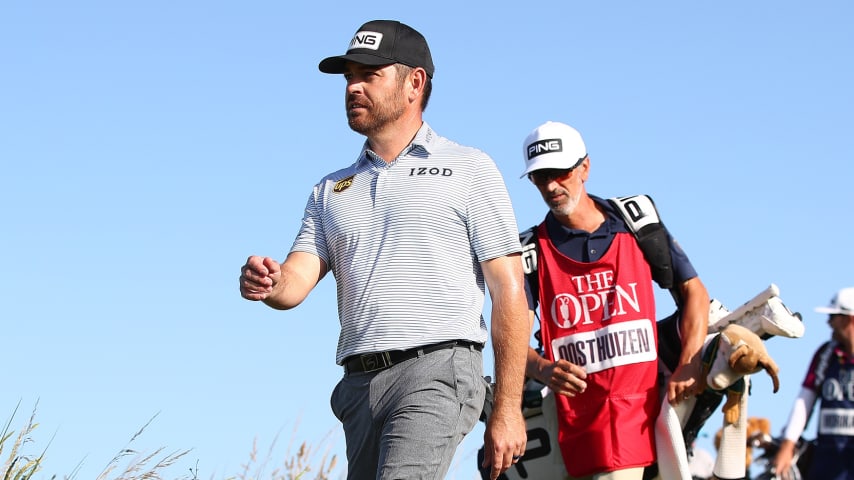Expect less of the unexpected at Royal St. George’s this time
5 Min Read

SANDWICH, ENGLAND - JULY 20: An aerial view of the par 4, 12th hole the host venue for the 2021 Open Championship at The Royal St. George's Golf Club on July 20, 2020 in Sandwich, England. (Photo by David Cannon/Getty Images)
SANDWICH, England – Adam Scott walked off from a practice round late Tuesday evening at Royal St. George’s with a satisfied grin. “She’s way fairer than she used to be,” the Aussie beamed.
She – in this case – was Royal St. George’s. The Open Championship course Scott battled away on in 2003 and 2011 brings a unique challenge. Call them mounds, moguls, humps or bumps – whatever you prefer. But they litter the fairways on this links course and can send a good shot into a not so good place.
It is one of the reasons why the final-round 64 from Scott’s idol, Greg Norman, in his triumph at the 1993 Open was lauded as one of the greatest in major history.
Norman was the first Open champion with four rounds in the 60s (four others have since joined him) and his 267 was the lowest winning total in Open history (Henrik Stenson’ 264 and final round 63 from 2016 are now records).
Gene Sarazen, who was 91 when he witnessed Norman’s round, called it, “the greatest championship in all my 70 years in golf.” Sarazen is one of five men to complete the career Grand Slam.
Trawl through old interviews and you can find a plethora of players referencing the luck needed at Royal St. George’s. It helps one better understand why long-shots Ben Curtis (2003) and Darren Clarke (2011) triumphed here.
“This course certainly puts a demand on trying to get the right bounce, that's for sure. These fairways are very difficult to try and hit, especially with all the mounding in them. And anytime the wind blows it makes it even more difficult,” Tiger Woods said pre-2003.
While it has hosted the fourth-most Opens, and most in England, Royal St. George’s has rarely been called anyone’s favorite, most likely because – as Justin Rose put it in 2011 – it’s “almost like playing on the surface of the moon.”
Scotland’s Sandy Lyle, winner of the 1985 Open, put Royal St. George’s in a class with Carnoustie and Royal Birkdale as “the beasts” of the Open rota. A combined seven players have finished under par in the past two Opens at St. George’s.
“There are no adjoining fairways like a lot of links courses,” Lyle told ESPN. “You get deeper and deeper into the rubbish. You have to be very accurate in places and it's not a very friendly course if it is breezy.”
And Norman himself prior to his domination in 1993 said, “I’d swear the Royal Air Force used a couple of the fairways for bombing runs.”
But Scott is among many who believe the disproportionate bad luck of the past should be tempered this time around. Rory McIlroy, who finished T25 in 2011, concurs after his early preparation for this year's Open.
“I walked away from the golf course on Saturday and Sunday thinking, this is a much better golf course than I remember it being, and I think that's just because of the way it's playing right now,” said McIlroy, a two-time FedExCup champion.
“It's certainly not as penal or unfair as it has been in previous years. 2011, it was a little bit like that, but looking back to '03, for example, it looked really burnt and crispy then, and it looked like a bit of a pinball machine out there. But that's not going to be the case this week. It's a lot more lush. It's a lot more green.
“I think it's perfect, and as the days go on with a little bit of wind and sunshine, by the weekend it should just be absolutely perfect. It should be playing the way it should play.”
England's Lee Westwood believes officials will look to keep the fairways in check to further avoid the bad luck bounce. The veteran faces his 88th major start and should he not win, he will own the longest streak without a victory.
“The fairways are softer than they were last time. I spoke to (R&A chief executive) Martin Slumbers on Monday evening, and he said they're probably going to water some of the fairways to stop that happening, as well,” Westwood revealed.
“You can't have really bouncy fairways carrying it off into rough that's this high that you're hacking out of.
“This course was laid down with the fairways like that and undulating, designed to go into the rough where you'd have a shot but it would be a flying lie and you'd have to judge that. It wasn't designed to land in the fairways and go into rough where you're hacking out with lob wedge. I think they're probably trying to get more into that.”
Marc Leishman is facing his first Open Championship on the course. He has three top-6 finishes previously in this major and is regarded by some as a links golf specialist. The six-time TOUR winner says it’s not the bad bounces that will matter – it’s your response to them.
“That’s the beauty of links golf sometimes,” Leishman said. “You know you’ll get the odd quirky bounce here and there and it might be frustrating but you have to be able to let it go and move on.
“I try to see each shot I’m asked to play as an opportunity to use my creativity or golf brain so to speak. When you embrace the different questions links golf asks you and be prepared to accept there might be a few answers that would not normally be the case, then good things can happen.”
Good things won’t happen to those players who spray the ball wide off the tee though. The thick luscious rough Westwood referenced awaits – the type where escaping can feel near impossible. Woods lost his first ball in pro golf on his first tee shot in 2003. Jerry Kelly made an 11 on the same hole without losing a ball.
So while there may be less carnage, there will still be enough to satisfy those who enjoy watching that sort of thing.





